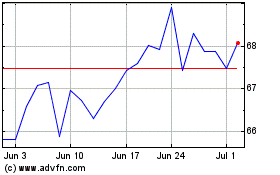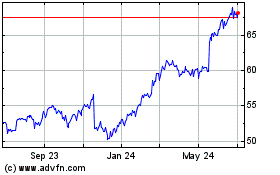By Sarah Nassauer
Wal-Mart Stores Inc.'s efforts to improve its stores, coupled
with wage gains by its core U.S. lower-income shoppers, helped
power the retail giant through a quarter where many of its
competitors struggled with soft demand.
The world's biggest retailer posted an unexpected nearly 1%
increase in first quarter revenue and predicted sales in existing
stores would rise this quarter, bucking a string of weak results
from other U.S. retailers.
Wal-Mart's shares jumped 9.6% to $69.20 at 4 p.m. in New York
trading on Thursday, one of the stock's largest one-day percentage
gains since October 2008, according to FactSet.
Wal-Mart has been spending heavily to draw customers to its
stores, better stocking shelves and increasing pay for its
employees, efforts that aided sales, executives said.
In addition, it benefited from the strength of lower-income
customers and broad shifts in retail away from some products such
as clothing. Wal-Mart gets more than half its U.S. revenue from
food and groceries, an area that has been slow to shift online.
Its sizeable grocery sales make Wal-Mart less dependent on
apparel than many chains or department stores. Macy's Inc. and
Target Corp. recently cited a pullback by U.S. shoppers last
quarter for disappointing results.
On Wednesday, Target's chief executive highlighted "an
increasingly volatile consumer environment" for the company's weak
results and outlook.
In contrast, at Wal-Mart there was "not a lot of variability
throughout the quarter," said finance chief Brett Biggs during a
conference call. "There is still a little bit of what I call an era
of uncertainty with consumers in terms of how they spend their
money," but wage increases and lower fuel prices are helping
Wal-Mart customers, he said.
While some clothing retailers have stumbled recently, Wal-Mart's
apparel business fared well because it focused on affordable
basics, not fashion-forward clothes, Mr. Biggs said. "There is
demand for that," he added.
Pay increases among Wal-Mart's lower-income shoppers, are likely
helping to drive sales at discount retailers, said Simeon Gutman,
an analyst at Morgan Stanley. Lower-income consumer wages rose 4%
in the first quarter, he estimated.
Still, Wal-Mart has warned heavy investments in stores and
online sales to fend off Amazon.com Inc. would dent profits this
fiscal year. The number of people visiting Wal-Mart stores rose
1.5% last quarter, but profit fell 7.8%.
"Numbers are not great by any means, but they are good compared
to what expectations were," said Brian Yarbrough, retail analyst at
brokerage Edward Jones.
Sales at Wal-Mart's U.S. stores open at least a year rose 1% in
the quarter ended April 30 -- the seventh straight quarter of
gains. Total revenue was $115.9 billion, including overseas stores
and its Sam's Club warehouse chain.
Excluding currency swings, Wal-Mart said its global revenue rose
4%. The strong dollar and a weak performance in the U.K. diminished
international sales, which declined 7.2% compared with a year
earlier to $28.1 billion in the quarter.
"We are encouraged by the Wal-Mart U.S. comp and believe it's
attributable to real improvement in our store experience," Wal-Mart
Chief Executive Doug McMillon said during a conference call.
Executives predicted that U.S. same-store sales would rise about
1% in the current quarter.
Wal-Mart has worked to clear out aisles and backrooms, reducing
display space to make stores more efficient. An apparent sign the
plan is working, total inventory in the quarter declined 3.5%, and
in-stock levels improved, the company said.
Results on Thursday showed a low-single digit decline in grocery
sales.
Wal-Mart U.S. CEO Greg Foran said the retailer began to lower
prices this past quarter on "key items" as part of a
multibillion-dollar investment in prices, a plan flagged by the
company in recent investor presentations.
One area remains a sore point: lagging e-commerce sales. The
company is investing billions of dollars in building new
fulfillment warehouses to speed delivery times and increase the
number of products sold on its Walmart.com website.
Growth in its global e-commerce sales, however, continued to
slow, rising 7% in the first quarter, down from 8% growth in the
fourth quarter and 17% growth in the year-earlier period.
It has "taken time to set the foundation for this business," Mr.
Biggs said. "We do expect as a company to see more growth in this
business."
Overall, Wal-Mart posted a fiscal first-quarter profit of $3.08
billion, or 98 cents a share, down from $3.34 billion, or $1.03 a
share, a year earlier.
Wal-Mart had forecast per-share earnings of between 80 cents and
95 cents. Analysts anticipated 88 cents a share.
For the current quarter, the company said it expects per-share
earnings of between 95 cents and $1.08. Analysts were expecting a
second-quarter profit of 98 cents a share.
Write to Sarah Nassauer at sarah.nassauer@wsj.com
(END) Dow Jones Newswires
May 20, 2016 02:48 ET (06:48 GMT)
Copyright (c) 2016 Dow Jones & Company, Inc.
Walmart (NYSE:WMT)
Historical Stock Chart
From Mar 2024 to Apr 2024

Walmart (NYSE:WMT)
Historical Stock Chart
From Apr 2023 to Apr 2024
